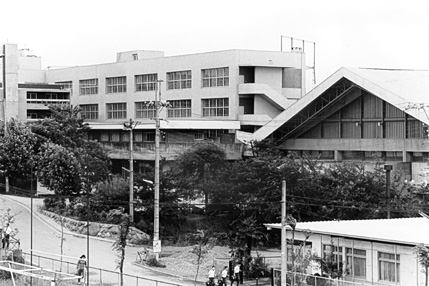Oberlin's impact on the rest of the world started with its involvement in the abolitionist movement and the Underground Railroad. Also, part of the mission of Oberlin College has been to help enrich the lives of others by bringing education and religion to other parts of the world. The people of Oberlin have thought it important to develop and keep connections beyond our boundaries.
Our Oberlin, Ohio is unique in many ways but the name Oberlin is not. Oberlinians have carried their pride in their town and college to many distant places. There are at least twelve Oberlins in this country that have a connection to ours.
There is an Oberlin in Kansas, as well as Pennsylvania, Louisiana, Michigan, Montana, Oklahoma, and North Carolina. They were not all named after John Frederick Oberlin, though - only Oberlin, Ohio and Oberlin, Pennsylvania. The others, like Oberlin, Kansas are either namesakes or named after the college.
Oberlin, Kansas (population 2,200) is a small farm town. It was once named Westfield. In 1873 John Rodehaver, its founder, left Oberlin, Ohio to homestead in Kansas. He became a very important citizen of the town. Mr. Rodehaver later donated a large amount of his land to the town. At his request the town was renamed Oberlin.
Oberlin, Pennsylvania is a small crossroads town. It is located near the state capital of Harrisburg. This Oberlin was named after John Frederick Oberlin.
The Oberlin that is in Louisiana is also a small farm town. It has a population of about 2,000. This town was founded by farmers who moved from Oberlin, Ohio in the 1890's. They purchased about 160 acres of land from a railroad and decided to call it Oberlin.
The state of Michigan has two Oberlins. One, in the northern part of the state, was once a logging settlement. It is now abandoned, except for a few homes and buildings. The second Oberlin was also a logging town that was abandoned in the late 1880's. It is just a crossroads now - in the northwestern part of lower Michigan.
Oberlin Village is near Raleigh, North Carolina. It was settled by freed slaves shortly after the Civil War. James A. Harris, a Black American who some say had his education at Oberlin College, was the head of a land company there and active in public life. He was an outstanding Negro, in public life, during the time after the Civil War.
Montana has two Oberlins as well, but neither are towns. Mount Oberlin is a mountain in Glacier National Park. It was named by two Oberlin College students that climbed it in 1905 while on an expedition. The other Oberlin is the name of the waterfall on the mountain.
The Oberlins of Oklahoma have a close connection. Philo P. Stewart, the man who founded Oberlin College, worked as a missionary with the Choctaw Indians in Oklahoma about 33 years before he came to Ohio. The land making up the town was once set aside for these Indian tribes. There is no one living there now, but nearby is New Oberlin, with a population of about 60 people.
Traveling along Lake Erie you may come across Oberlin Beach, located outside of Huron in Erie County. It was named earlier in this century by some Oberlin College professors who built their summer homes there.
View other sites devoted to Oberlin, Kansas: Oberlin, Kansas Fact File and A Guide to Oberlin, Kansas
Oberlins connections go beyond the United States to other parts of the world. Farther north in Ontario, Canada is an island called Oberlin Bay, which is on the eastern shore of the Georgian Bay. In 1904, a group of Oberlin College professors went on a canoe trip. They chose an island, purchased it, and built cottages the following year.
In the West Indies island of Jamaica is the Oberlin Complex. In 1837 a graduate of Oberlin College, David S. Ingraham, started a group of missions there. This was about three years after some 800,000 slaves there were freed by the British government. The missionaries helped the people by teaching them basic subjects. In all, some 36 Oberlin missionaries served in Jamaica. The Oberlin Complex, which today has an Oberlin Church, High School, and Medical Center was named after Oberlin College.
 Obirin
(o-bee-deen) University is located in Japan near Tokyo, Japan's
capital. It was started in 1946 by Oberlin College graduates from
Japan who first went to China as missionaries. In Peking, China they
began a school for girls. After World War II they started a new
school in Japan. Today, Obirin University has a kindergarten,
elementary school, high school, junior college, and college. This
college was named in honor of John Frederick Oberlin. Also, the word
obirin, in Japanese, means "beautiful cherry orchard". The university
was actually started in a cherry orchard!
Obirin
(o-bee-deen) University is located in Japan near Tokyo, Japan's
capital. It was started in 1946 by Oberlin College graduates from
Japan who first went to China as missionaries. In Peking, China they
began a school for girls. After World War II they started a new
school in Japan. Today, Obirin University has a kindergarten,
elementary school, high school, junior college, and college. This
college was named in honor of John Frederick Oberlin. Also, the word
obirin, in Japanese, means "beautiful cherry orchard". The university
was actually started in a cherry orchard!
The Shansi
Association at Oberlin College has an exchange program with
Obirin University. Oberlin College sends their graduates to teach
English. Obirin University sends their students to study here.

The Oberlin College in China was started in 1907 by a woman whose husband was killed during the Boxer Rebellion. She started the school in memory of the missionaries and their families who died there. The Memorial Arch in Tappan Square was also built in their honor. The school, which was open until 1951, had both a high school and a college. This school has reopened with another name but still has ties with Oberlin.
India and Taiwan are two other places with an Oberlin connection. They have three different colleges with buildings that are named Oberlin. And yet another country, Indonesia, has a college that sends students to study here.
Another connection Oberlin has is through its "sister cities". The sister city program was established to promote peace, good-will, and a better understanding of different people and their cultures. Cities that are "paired" have something in common with each other.
Oberlin currently has two sister cities. One is the city of Ile Ife (eelay eefay - which means "old city"). It is located in the country of Nigeria on the continent of Africa. The other is the city of Suzdal (sooz-dal), in Russia, a country in Europe.
Ile Ife, popularly known as Ife, has been our sister city since 1975. Ile Ife is the oldest town of the Yoruba people and is considered their holy birthplace.
Ife is similar to Oberlin in several ways. Both cities have diverse populations. Ile Ife, like Oberlin, is a college town. The University of Ife was started in 1961 and has an enrollment of about 8,000 students. Although the population of Ife at 130,000 is much larger than Oberlin's, the area of both cities is about the same.
In modern times Ife has become well-known among historians, archaeologists and artists for its wealth of old treasures. Diggings have uncovered pieces made from many kinds of materials including wood, terra cotta earthenware, and bronze - dating as far back as 500 B.C. The Ife Town Museum contains many of these artifacts.
In 1983 Oberlin celebrated its sesquicentennial - the 150th anniversary of its founding. Four representatives from Ife came to help us celebrate, including the mayor of Ife. One of the men, Professor Nelson Ngoka, visited the Oberlin schools and talked with the students. Soon after, letters were exchanged between the students of Langston School (then named Oberlin Middle School) and a school in Ile Ife.
Suzdal became our sister city in 1991. It has a population of about 15,000 and is located approximately 160 miles east of Moscow, the capital of Russia. One way Suzdal is similar to Oberlin is in its size. Another is that it has a rich heritage as does our Oberlin. Both cities have an impact on the larger communities around them.
The history of Suzdal goes back about 1,000 years. It was once the capital of ancient Russia. Suzdal is known for its many churches which have been built throughout its history. There are about fifty churches standing today. Suzdal also has an ancient fortress which was built to help protect the city from invasions.
Oberlin may be a small town, but we know it as a World City.
Learn also about Suzdal, Russia -- and see many images of the city!
Do you think it's important for our small town to have connections beyond its borders? Explain.
Oberlin: Yesterday, Today, Tomorrow Home
Page | Table of Contents | ![]()
![]()